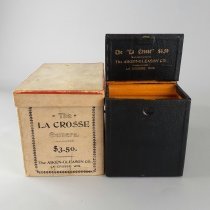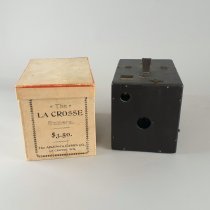Object Record
Images


Metadata
Object Name |
Camera, Box |
Catalog Number |
2020.009.01 |
Description |
The La Crosse Camera with orginal cardboard box manufactured by the Aiken-Gleason Company. Wooden rectangular box camera covered in a fine grain leather with a single achromatic fixed focus lens and a leather handle. |
Provenance |
Made by the Aiken-Gleason Company of La Crosse. |
Made By |
Aiken-Gleason Company |
Date |
c. 1897 |
Material |
Wood, Leather, Cardboard |
Dimensions |
H-5.5 W-5 L-7.75 inches |
Length (in) |
7.750 |
Height (in) |
5.500 |
Width (in) |
5.000 |
Place of Origin |
La Crosse, Wisconsin |
Subjects |
Businesses |
Search Terms |
Aiken-Gleason Company Made in La Crosse |
Notes |
The La Crosse camera was manufactured by the Aiken-Gleason Co. of La Crosse Wisconsin in circa 1897. This camera was made in two sizes, the La Crosse Junior capable of taking 2 1/2 x 2 1/2 inch exposures and the Senior capable of taking 3 1/2 x 3 1/2 inch exposures. Both cameras were constructed of wood and covered in real fine grain leather. Both were equipped with a single achromatic fixed focus lens accompanied with a patent safety shutter providing both time and instantaneous pictures. Additional features included a leather handle, tripod socket and a brilliant view finder. The La Crosse Junior camera was priced $2.50 and the La Crosse Senior $3.50. Featured in Things that Matter: This camera named the La Crosse was manufactured in La Crosse in 1896 by the Aiken-Gleason Co. The company was founded in 1893 by Frank Aiken and his son-in-law Eugene Gleason. Both men were longtime local residents, so it makes sense that they had enough pride in the city to name a camera after their hometown. In fact, another camera was named after La Crosse’s neighbor in Minnesota, the Crescent. Other models made by the firm included the Comet, Peek-a Boo, Cycle Peek-a-Boo and Imperial. Frank Aiken was born in Pennsylvania and moved to Onalaska with his parents in 1858. He served in the Civil War, and afterward worked as a mill-wright at several local lumber mills. His partner, Eugene Gleason, was born in Onalaska in 1866 and became a machinist in the lumber industry. Gleason began manufacturing his patented Comet Camera in Onalaska in 1893. The two men formed a business relationship and incorporated as the Aiken-Gleason Co. about 1896, moving their factory to La Crosse at the time, located at Seventh and La Crosse streets. The La Crosse camera was an up-to-date device for the amateur photographer of the day. Made of wood covered in fine grain leather, it featured a leather handle, a tripod socket and a viewfinder. Its fixed focus lens was accompanied by a patented shutter that allowed both timed and instant exposures. The La Crosse camera cost $3.50, with a smaller version available for $2.50. Made long before the digital age, the La Crosse camera required light-sensitive film to create a photograph. Three and a half inches square, the film was manufactured on either a glass plate or on the recently developed plastic base made of cellulose nitrate. The film was placed in a light-proof film holder and positioned inside the camera. After taking the photograph, the holder was exchanged for another one with unexposed film before taking another image. It was certainly a laborious process compared to today’s cell phone cameras. In 1901, the Aiken-Gleason Co. changed its name to the Imperial Camera & Manufacturing Co. The firm ran into financial troubles during an economic downturn and sold out to the Century Camera Co. of Rochester, New York, in 1903. It was eventually absorbed into Eastman Kodak Co. This article was originally published in the La Crosse Tribune. Title: Camera Named for La Crosse Author: Robert Mullen Publish Date: September 19, 2020 |